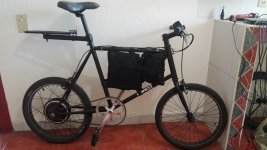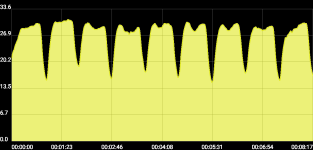MexicanElmo
1 mW
- Joined
- Aug 10, 2017
- Messages
- 14
Hello Guys,
I wanted to share with you my first ebike build. Basically what I was trying to do was to show Supercapacitors characteristics and their efficiency along Regen.
My build is based on:
-A 17 F 48 V Maxwell Technologies Supercap module (aproximately 5.44 Wh)
-A kelly controller rated to 50 A max
- A BLDC DD 400W motor (Smart Pie, Golden Motor)
- A 20 inch Wheel Minivelo from a company called Respect Cycles (don't buy from them)
So what I wanted to build was an ebike (standalone, no wall charging at all) that could get regen and use that Regen energy to help a little bit. So here it is.

Weighting somewhere about 19-20 kg. Capacitor Bank is less than 2kg, hub motor about 6kg and electronics, bags, wiring, ebrake, vmeter, thumb throttle should be 2 kg total.
How I chose the components?
-I chose small tires because I like small bikes and took the high RPM/high efficiency as a good thing. Minivelos are fast, light, sturdier and cheaper than folding bikes.
-The controller had regen, plenty of power, was cheap, had an RS 232 interface to configure along a PC and had a protection feature for the battery(which later on I found to be useless).
-The BLDC was lighter than other DD motors, less visible, I red somewhere that this motor's cogging was almost unnoticeable and I thought it was enough power at that moment.
-The capacitor bank was not that expensive, small, and while I could buy the cells alone and build a better suited one, maybe half the size and less leakage prone I also wasnt used to working with supercaps and I didn't want to destroy anything.
Ok, so nowmfor those that are not really familiar with supercaps, here's a little bit of info on them.
-Just like batteries you can ruin them if you overvoltage them
-Unlike batteries you can leave them at 0V for years with no damage
-Are not flamable, explosive or dangerous to handle
-Are made mainly from carbon and an electrolyte, so in theory it's cheaper to get raw materials to build them.
-Have 500, 000 lifecycles or more.
-You can withdraw or enter as much current out/in as long as you don't overheat them (lets say that 65°C is a damaging temperature).
-Can operate at -40°C
-The charge/discharge rate can be the same, unlike batteries which have less charging capacity
-Is somehow easier to balance a parallel/series configuration than on batteries.
-Are about 30% more efficient than Li-ion batteries when realeasing or receiving energy, meaning that internal resistance is lower.
-Are about 1/50 less energy dense than Li-ion batteries.
-Are more sensitive to vibrations than Li-ion Batteries.
-Have an exponential charge/discharge curve unlike batteries.
I'm sure I'm forgetting many but lets get to the point.
So I wanted to capture energy from just regen and use it, insted of wasting it on my brakepads.
Unfortunately I have not much test equipment so most of measurements come from a handheld DMM (voltmeter), a cycling android app (cycledoid), and indirect measurements. I wish I had access to a power meter or torque sensor but... exchange rate is not in my favor haha.
So here's my test bench

Yeah, I configured on a certain regen % the bike, rode to that bridge, steping on the very first slope corner, let the bike start moving by gravity, press the brake and stop from 7 to 11 m after the slope ended. So I measured that first slope height, the weight of the bike, my weight, the initial measurement of the voltage in the supercap bank, the final voltage, the supercap value, then rode up again about 6 times to repeat the Vi, Vf measurement, then went home, change the %, then back to the bridge...
(kelly controller is current limited on regen but it's not displayed on Amps, it's displayed on %, so I can just guess what current I was getting into the Supercaps by looking at the performance data from the motor)
I tried to perform this measurments while having the Supercap bank in the 41-47 V region to keep current levels down.
So I got this graph, which shows the average efficiencies of the measurments I took.

I believe that above 86% in regen means over 12 A for the kelly controller, as the performance curve for the smart pie shows a decrease in efficiency when it's working above 12 Amps, and below 64% it takes to much time for the bike to slow down so aerodynamics and rolling losses take over and efficiencies are then lower than 40%. Of course all of this was at very low speed, maybe less than 10 km/h.
I also set the kelly controller to 100% regen, which I believe is pretty much like shorting all the phases together because I could come to a stop from 30 km/h to 0 in maybe 4 seconds, that setting gave me efficiencies in the 25-30% range. Which is not that bad if you consider I had almost a short circuit in there!
I rode around the city for a couple of days with all the electronics and trying to get the most regen possible, setting the regen % at 77, avoiding the machanical brakes, avoiding emergency stops, looking to "take advantage" of red lights then using that little power to speed up quickly and getting to a nice speed of lets say 25 km/h, staying on leg power until the next red light to engage regen again and so on. I also must say that as my first time riding an ebike, I found kind of akward the feeling of outrunning the motor at 30 km/m with certain ease, no speed limits were configured btw, is just that 45-48 volts were just not enough to make this little wheel turn fast enough. However I was quite impressed about the wheelies I was able to make while pedaling and engaging the motor from stop.
After a few days for comparison purposes I stripped my bike from all the electric/electronic stuff, leaving the bike really light (about 10 kg) and rode around for a couple of days, I could feel it lighter while pedaling, more agile, I felt I could pedal for longer at speeds over 30 km/h, so I really noticed the cogging was not there anymore, I also was more willing to coast along insted of braking. Another feeling about having a normal bike was not being too afraid of getting it stolen or damaged, because even as ugly as it seems in the fist picture... it has been quite expensive to get all those things to Mexico.
So I made another test, I decided to ride on the nearby velodrome

for 9 laps, between every lap making one slowdown to almost 0 km/h, then accelerate again, all of this well rested, trying to keep a speed that won't exhaust me, in order to pedal back home just fine, but to make it quick, I monitored my speed with the android app, this first 9 laps were performed with the bike stripped down from all electric stuff.
So I got an average speed of 26.6 km/h, most of the top speeds I registered were about 30 km/h and despite coming to a total stop in between laps the gps logger would just register it at about 15 km/h it should be that the rate of the measurements is not that fast.

That's the resulting graph for those 9 laps.
Then I loaded the bike with the motor and electronics, rested and repeated everything the next day. My goal for the next day was to look for a boost in speed, or in take off, or a notorious effortless drive this time so I aimed to have a similar or better average speed, also trying not to feel exhausted while doing so. The only differences this time were me doing some prior laps... to charge the supercapacitor bank to it's max, that took maybe 6 laps and lots of braking, and that it took me about 1.5 times the lenght of the previous test to brake to an almost full stop, this due to me leaving the regen setting at about 77% which I thought was optimal for efficiency.

So that's the resulting graph, which is almost the same, I got an average speed of 26.9 km/h, tops speeds were the same, low speeds were a little bit higher, I believe that it was due to the almost immediate catchup in speed thanks to the motor. Other than that, basically everything was the same, the overall time, my exahaustation level, I think even it was a little harder the second test. But what I'm trying to say is that there was not a really noticeable difference.
However I think I'm still not done with this tests. Maybe I do with this setup but not with the whole supercap/regen idea. So what I want to do is:
-build another supercap bank, with way less leakage, active balancing, with less farads but higher voltage, a little bit smaller and less power capable but it will still be able receive 1 or 1.5 kw no problem, maybe rated at 100 V or 80V, why? to keep currents down.
-Modify a BMC type of hub motor, wind it for low rpm, and somehow enable some kind of an active bidirectional ratchet system, to be able to get rid of the cogging while not in use.
-Design a control, BLDC motor controls are not designed to have Supercaps as power supplies, so mine will have a wider operating voltage rage, in order to get boost capabilities from 3.3 V until the supercap voltage rating, an effective circuit to protect supercap from overvoltage, an algorithm that only operates throttle after certain voltage to increase efficiency, otherwise just regen mode until the efficient voltage levels are achieved.
Maybe after this modifications I can have a 5kg conversion kit, and without the cogging being there I should be able to notice an increase in range or speed while mantaining a "off the grid" bike.
What do you think? Do you have any suggestions to improve this? any questions? Any criticism about my lack of previous simulations, calculations and so on :lol: ?
Thanks for reading my odd english... I'm not native as you can see.
I wanted to share with you my first ebike build. Basically what I was trying to do was to show Supercapacitors characteristics and their efficiency along Regen.
My build is based on:
-A 17 F 48 V Maxwell Technologies Supercap module (aproximately 5.44 Wh)
-A kelly controller rated to 50 A max
- A BLDC DD 400W motor (Smart Pie, Golden Motor)
- A 20 inch Wheel Minivelo from a company called Respect Cycles (don't buy from them)
So what I wanted to build was an ebike (standalone, no wall charging at all) that could get regen and use that Regen energy to help a little bit. So here it is.

Weighting somewhere about 19-20 kg. Capacitor Bank is less than 2kg, hub motor about 6kg and electronics, bags, wiring, ebrake, vmeter, thumb throttle should be 2 kg total.
How I chose the components?
-I chose small tires because I like small bikes and took the high RPM/high efficiency as a good thing. Minivelos are fast, light, sturdier and cheaper than folding bikes.
-The controller had regen, plenty of power, was cheap, had an RS 232 interface to configure along a PC and had a protection feature for the battery(which later on I found to be useless).
-The BLDC was lighter than other DD motors, less visible, I red somewhere that this motor's cogging was almost unnoticeable and I thought it was enough power at that moment.
-The capacitor bank was not that expensive, small, and while I could buy the cells alone and build a better suited one, maybe half the size and less leakage prone I also wasnt used to working with supercaps and I didn't want to destroy anything.
Ok, so nowmfor those that are not really familiar with supercaps, here's a little bit of info on them.
-Just like batteries you can ruin them if you overvoltage them
-Unlike batteries you can leave them at 0V for years with no damage
-Are not flamable, explosive or dangerous to handle
-Are made mainly from carbon and an electrolyte, so in theory it's cheaper to get raw materials to build them.
-Have 500, 000 lifecycles or more.
-You can withdraw or enter as much current out/in as long as you don't overheat them (lets say that 65°C is a damaging temperature).
-Can operate at -40°C
-The charge/discharge rate can be the same, unlike batteries which have less charging capacity
-Is somehow easier to balance a parallel/series configuration than on batteries.
-Are about 30% more efficient than Li-ion batteries when realeasing or receiving energy, meaning that internal resistance is lower.
-Are about 1/50 less energy dense than Li-ion batteries.
-Are more sensitive to vibrations than Li-ion Batteries.
-Have an exponential charge/discharge curve unlike batteries.
I'm sure I'm forgetting many but lets get to the point.
So I wanted to capture energy from just regen and use it, insted of wasting it on my brakepads.
Unfortunately I have not much test equipment so most of measurements come from a handheld DMM (voltmeter), a cycling android app (cycledoid), and indirect measurements. I wish I had access to a power meter or torque sensor but... exchange rate is not in my favor haha.
So here's my test bench

Yeah, I configured on a certain regen % the bike, rode to that bridge, steping on the very first slope corner, let the bike start moving by gravity, press the brake and stop from 7 to 11 m after the slope ended. So I measured that first slope height, the weight of the bike, my weight, the initial measurement of the voltage in the supercap bank, the final voltage, the supercap value, then rode up again about 6 times to repeat the Vi, Vf measurement, then went home, change the %, then back to the bridge...
(kelly controller is current limited on regen but it's not displayed on Amps, it's displayed on %, so I can just guess what current I was getting into the Supercaps by looking at the performance data from the motor)
I tried to perform this measurments while having the Supercap bank in the 41-47 V region to keep current levels down.
So I got this graph, which shows the average efficiencies of the measurments I took.

I believe that above 86% in regen means over 12 A for the kelly controller, as the performance curve for the smart pie shows a decrease in efficiency when it's working above 12 Amps, and below 64% it takes to much time for the bike to slow down so aerodynamics and rolling losses take over and efficiencies are then lower than 40%. Of course all of this was at very low speed, maybe less than 10 km/h.
I also set the kelly controller to 100% regen, which I believe is pretty much like shorting all the phases together because I could come to a stop from 30 km/h to 0 in maybe 4 seconds, that setting gave me efficiencies in the 25-30% range. Which is not that bad if you consider I had almost a short circuit in there!
I rode around the city for a couple of days with all the electronics and trying to get the most regen possible, setting the regen % at 77, avoiding the machanical brakes, avoiding emergency stops, looking to "take advantage" of red lights then using that little power to speed up quickly and getting to a nice speed of lets say 25 km/h, staying on leg power until the next red light to engage regen again and so on. I also must say that as my first time riding an ebike, I found kind of akward the feeling of outrunning the motor at 30 km/m with certain ease, no speed limits were configured btw, is just that 45-48 volts were just not enough to make this little wheel turn fast enough. However I was quite impressed about the wheelies I was able to make while pedaling and engaging the motor from stop.
After a few days for comparison purposes I stripped my bike from all the electric/electronic stuff, leaving the bike really light (about 10 kg) and rode around for a couple of days, I could feel it lighter while pedaling, more agile, I felt I could pedal for longer at speeds over 30 km/h, so I really noticed the cogging was not there anymore, I also was more willing to coast along insted of braking. Another feeling about having a normal bike was not being too afraid of getting it stolen or damaged, because even as ugly as it seems in the fist picture... it has been quite expensive to get all those things to Mexico.
So I made another test, I decided to ride on the nearby velodrome

for 9 laps, between every lap making one slowdown to almost 0 km/h, then accelerate again, all of this well rested, trying to keep a speed that won't exhaust me, in order to pedal back home just fine, but to make it quick, I monitored my speed with the android app, this first 9 laps were performed with the bike stripped down from all electric stuff.
So I got an average speed of 26.6 km/h, most of the top speeds I registered were about 30 km/h and despite coming to a total stop in between laps the gps logger would just register it at about 15 km/h it should be that the rate of the measurements is not that fast.

That's the resulting graph for those 9 laps.
Then I loaded the bike with the motor and electronics, rested and repeated everything the next day. My goal for the next day was to look for a boost in speed, or in take off, or a notorious effortless drive this time so I aimed to have a similar or better average speed, also trying not to feel exhausted while doing so. The only differences this time were me doing some prior laps... to charge the supercapacitor bank to it's max, that took maybe 6 laps and lots of braking, and that it took me about 1.5 times the lenght of the previous test to brake to an almost full stop, this due to me leaving the regen setting at about 77% which I thought was optimal for efficiency.

So that's the resulting graph, which is almost the same, I got an average speed of 26.9 km/h, tops speeds were the same, low speeds were a little bit higher, I believe that it was due to the almost immediate catchup in speed thanks to the motor. Other than that, basically everything was the same, the overall time, my exahaustation level, I think even it was a little harder the second test. But what I'm trying to say is that there was not a really noticeable difference.
However I think I'm still not done with this tests. Maybe I do with this setup but not with the whole supercap/regen idea. So what I want to do is:
-build another supercap bank, with way less leakage, active balancing, with less farads but higher voltage, a little bit smaller and less power capable but it will still be able receive 1 or 1.5 kw no problem, maybe rated at 100 V or 80V, why? to keep currents down.
-Modify a BMC type of hub motor, wind it for low rpm, and somehow enable some kind of an active bidirectional ratchet system, to be able to get rid of the cogging while not in use.
-Design a control, BLDC motor controls are not designed to have Supercaps as power supplies, so mine will have a wider operating voltage rage, in order to get boost capabilities from 3.3 V until the supercap voltage rating, an effective circuit to protect supercap from overvoltage, an algorithm that only operates throttle after certain voltage to increase efficiency, otherwise just regen mode until the efficient voltage levels are achieved.
Maybe after this modifications I can have a 5kg conversion kit, and without the cogging being there I should be able to notice an increase in range or speed while mantaining a "off the grid" bike.
What do you think? Do you have any suggestions to improve this? any questions? Any criticism about my lack of previous simulations, calculations and so on :lol: ?
Thanks for reading my odd english... I'm not native as you can see.

